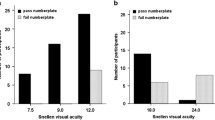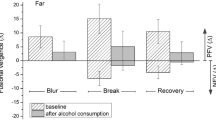Summary
In 1970 Aulhorn and Harms made fundamental recommendations for the night driving ability of motorists as well as for the corresponding examination methods. Reduced night driving ability of persons over the age of 60, as well the established limits for twilight vision and glare sensitivity, and their relevance to night-time collisions has been re-examined.
Patients and methods: A total of 117 normal volunteers between 10 and 79 years of age underwent ophthalmological examinations including measurement of contrast acuity and glare sensitivity by means of the Mesotest II (Oculus, Germany).
Results: Contrast acuity and glare sensitivity deteriorate in an age-dependent fashion. Thus, night driving ability decreased with increasing age. The majority part of persons over the age of 60 were not able to fulfill the actual criteria for night driving ability according to the recommendations of the German Ophthalmological Society (DOG).
Conclusions: In the present population, nearly 40 % of persons over the age of 60 have reduced night driving ability. Since Lachenmayr showed in the BAST study the correlation of reduced night driving ability and car accidents, this emphasizes the importance of ophthalmological check-ups for motorists at this age.
Zusammenfassung
Hintergrund: Aulhorn und Harms haben 1970 grundlegende Empfehlungen zur Nachtfahreignung von Kraftfahrern sowie zur entsprechenden Untersuchungsmethodik gegeben. Die Relevanz nachtfahruntauglicher Personen ab dem 60. Lebensjahr für sog. Dunkelheitsunfälle wird ebenso kontrovers beurteilt, wie die seinerzeit festgelegten Grenzwerte für das Dämmerungssehen und die Blendempfindlichkeit.
Patienten und Methoden: Bei 117 Normalpersonen zwischen dem 10. und 79. Lebensjahr erfolgten eine ophthalmologische Routineuntersuchung sowie eine Untersuchung am Mesoptometer II (Fa. Oculus, Deutschland).
Ergebnisse: Sowohl das Kontrastsehen als auch die Blendempfindlichkeit zeigten die seit Aulhorn und Harms bekannte deutliche Altersabhängigkeit. Die Nachtfahreignung nahm mit zunehmendem Alter ab. Ein großer Teil der untersuchten Personen ab dem 60. Lebensjahr erfüllten nicht die von der Deutschen Ophthalmologischen Gesellschaft empfohlenen Kriterien zur Nachtfahreignung.
Schlußfolgerung: Die von Aulhorn und Harms festgelegten Grenzwerte bedingen auch in der heutigen Population bei etwa 40 % der über 60 jährigen eine fehlende Nachtfahreignung. Da von Lachenmayr in der BAST-Studie eine fehlende Nachtfahreignung als Unfallrisikofaktor nachgewiesen wurde, unterstreicht dies die Forderung nach einer augenärztlichen Nachuntersuchung von Kraftfahrern ab diesem Lebensalter.
Similar content being viewed by others
Author information
Authors and Affiliations
Rights and permissions
About this article
Cite this article
Scharwey, K., Krzizok, T. & Herfurth, M. Night driving ability of persons with normal vision and variable age. Ophthalmologe 95, 555–558 (1998). https://doi.org/10.1007/s003470050315
Published:
Issue Date:
DOI: https://doi.org/10.1007/s003470050315




